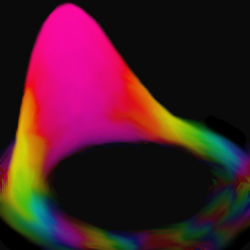A Tiny Solar System After All

Like a planet orbiting the sun, some ideas keep coming around. In the 1920s, the inventors of quantum mechanics scuttled the notion that an atom behaves like a tiny solar system. Whereas the planets orbit the sun in elliptical orbits, the electrons hover around the nucleus in diffuse cloud-like waves, known as orbitals, that describe only the probability of finding the electron at different places within the atom. But those orbitals can combine to form a clump-like “wave packet” that contains the electrons and does orbit the nucleus like a planet, researchers report in the 2 April PRL. The observation confirms a long-sought connection between the quantum and classical realms.
According to quantum mechanics, tiny objects like electrons do not have precise trajectories. Rather, they must be described by quantum waves of probability. Yet the quantum and classical realms must join smoothly, so somehow the rippling quantum waves must be able to mimic a classical trajectory.
Austrian theorist Erwin Schrödinger argued that quantum waves could do just that. Analyzing the quantum-mechanical version of a weight on a spring–the so-called harmonic oscillator–he showed in 1926 that the oscillator’s many quantum waves might add up to produce a single hump or “wave packet.” This packet would travel back and forth indefinitely, just like a classical weight on a spring. But there was a catch: To keep the component waves synchronized and prevent the wave packet from gradually getting wider, Schrödinger relied on a peculiarity of the harmonic oscillator and the energies of its quantum waves. Most real-world objects such as atoms don’t share that property, so their wave packets inevitably spread. For example, in 1988 researchers flashed laser light on an atom and created a wave packet that orbited the nucleus; however, it spread and faded away in just a few dozen orbits.
But shine microwaves on the atom and the wave packet can last for thousands of orbits, report Haruka Maeda and Thomas Gallagher of the University of Virginia in Charlottesville. The researchers used laser pulses to produce a wave packet that contained the outer electron of a lithium atom and traveled around the nucleus on an elongated elliptical orbit. They then applied microwaves whose electric field pointed in the same direction as the orbit stretched. The microwaves’ frequency also matched the rate at which the wave packet went around. The microwaves gently pushed on the packet, slowing down its front edge, speeding up its rear, and preventing it from spreading. The wave packet endured for 900 nanoseconds, enough time to complete roughly 15,000 orbits.
“None of us expected such nice results so soon,” says Joseph Eberly, a theorist at the University of Rochester in New York who first suggested the microwave technique 10 years ago. “It’s an experimental tour de force.” Carlos Stroud, an experimentalist at Rochester, says the analogy between the atomic state and the solar system is very deep, but not quite as simple as it seems. Strictly speaking, the wave packet is analogous not to a planet, but to two groups of asteroids that precede and follow Jupiter on its orbit around the sun. Jupiter’s gravity stabilizes the clouds of space rocks, which are known as the Trojan asteroids, in precisely the same way that the microwaves shepherd the wave packet around the atom, Stroud says: “Mathematically, they’re identical.”
–Adrian Cho
Adrian Cho is a freelance science writer in Grosse Pointe Woods, Michigan.
More Information
animation of a wave packet in the harmonic oscillator
Stroud’s web site includes the “Orbiting an Atom” animation above and others.


